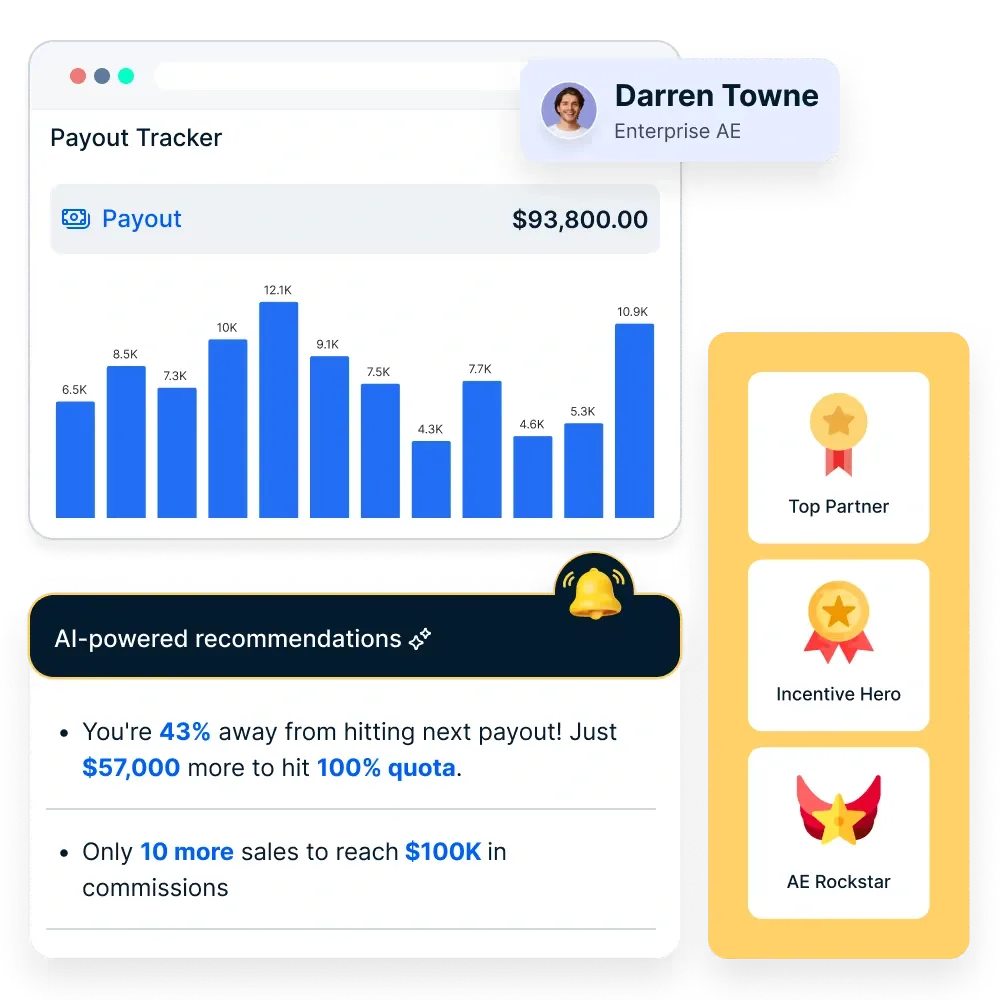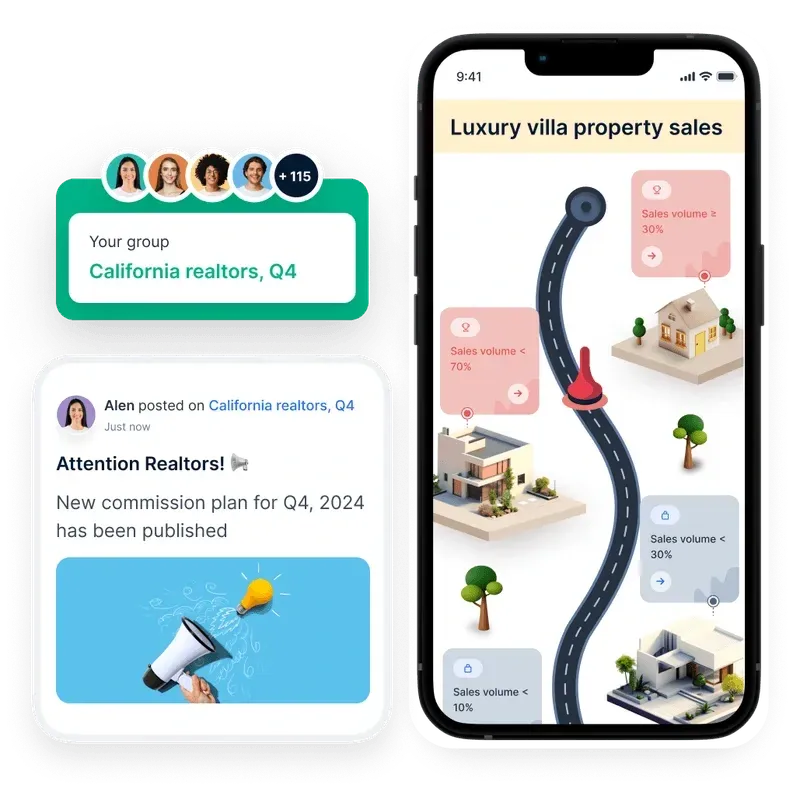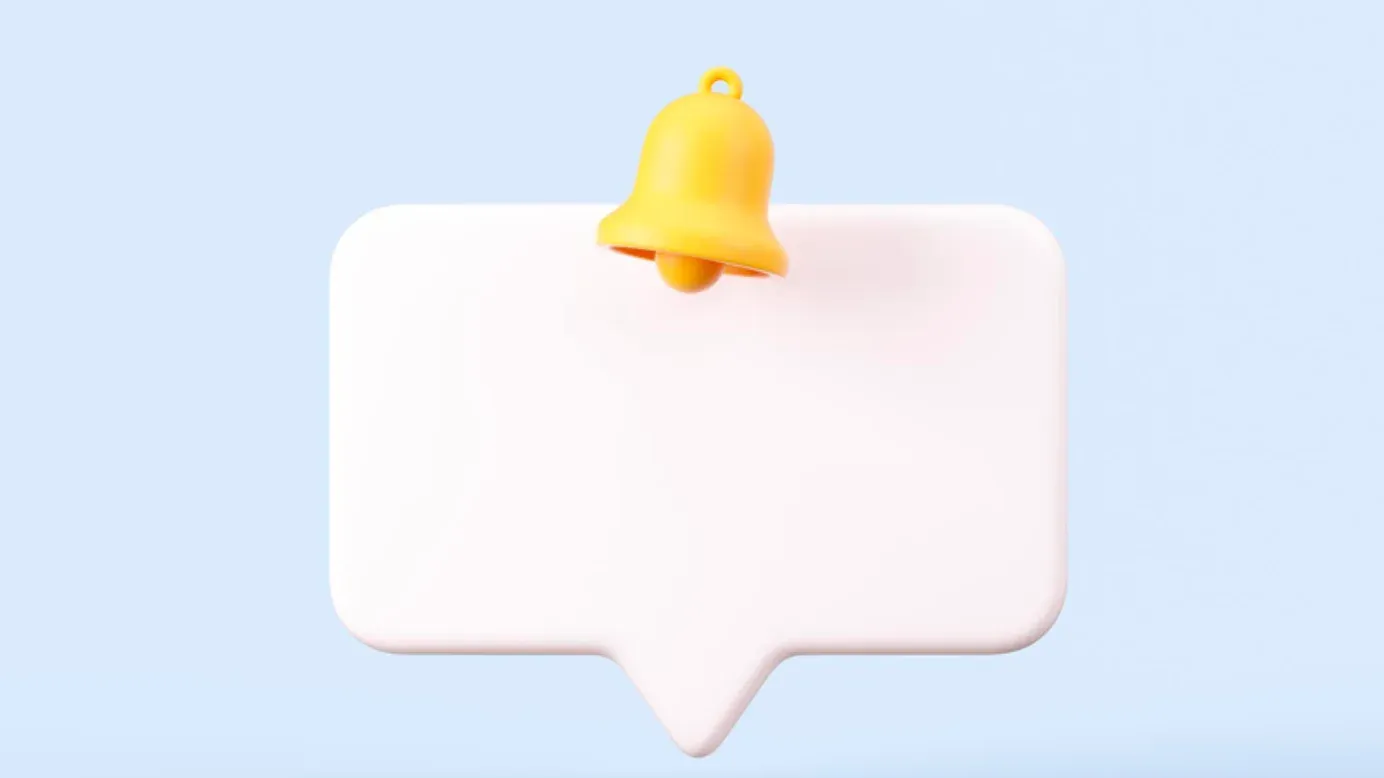Nutzung von Behavioral Nudges zur Verbesserung der Vertriebsleistung: Ein vollständiger Leitfaden
Bei der Vertriebsleistung geht es nicht nur um Ziele, sondern auch um konsistentes Verhalten. Entdecken Sie, wie Verhaltensanreize die Vertriebsleistung verbessern können, indem sie die Vertriebsmitarbeiter zu besseren Gewohnheiten anleiten, das Engagement erhöhen und die Konversionsrate steigern.
Auf dieser Seite
Vertriebsteams arbeiten in Umgebungen mit hohem Druck, in denen die Motivation schwanken kann, Entscheidungsmüdigkeit einsetzt und verpasste Folgeaufträge zu verpassten Chancen führen. Herkömmliche Verkaufsanreize wie Provisionen und Boni können zwar die Leistung steigern, führen aber oft nicht zu konsistenten, langfristigen Verhaltensänderungen. An dieser Stelle kommen Verhaltensanreize ins Spiel.
Ein Verhaltensstupser ist eine subtile, aber wirkungsvolle Aufforderung, die Personen ohne Zwang oder Einschränkung zu einer bestimmten Handlung bewegen soll. Diese Anstöße basieren auf psychologischen Prinzipien und beeinflussen die Entscheidungsfindung auf sanfte Weise in einer Weise, die Produktivität, Konsistenz und bessere Verkaufsgewohnheiten fördert. Anstatt Verkaufsteams mit strengen Regeln oder finanziellen Belohnungen unter Druck zu setzen, schaffen Nudges ein Umfeld, in dem die richtigen Verhaltensweisen auf natürliche Weise entstehen.
In diesem Blog gehen wir der Frage nach, wie verhaltensorientierte Anreize funktionieren, warum sie im Vertrieb wirksam sind und wie Unternehmen sie strategisch einsetzen können, um ihre Leistung ohne Mikromanagement oder zusätzliche finanzielle Anreize zu steigern.
Was sind Verhaltensanregungen?
Ein Verhaltensstupser ist eine psychologische Intervention, die darauf abzielt, Menschen auf subtile Weise zu einer gewünschten Handlung zu bewegen, ohne ihre Wahlmöglichkeiten einzuschränken. Im Gegensatz zu direkten Anreizen oder strikten Regeln wird bei Nudges das Umfeld oder der Entscheidungskontext so gestaltet, dass bestimmte Verhaltensweisen wahrscheinlicher werden.
Das Konzept ist in der Verhaltensökonomie verwurzelt, einem Bereich, der untersucht, wie kognitive Verzerrungen die Entscheidungsfindung beeinflussen. Der Wirtschaftsnobelpreisträger Richard Thaler und der Rechtswissenschaftler Cass Sunstein machten die Idee in ihrem Buch Nudge: Improving Decisions About Health, Wealth, and Happiness.
Im Vertrieb können Verhaltensanregungen die Art und Weise beeinflussen, wie Vertriebsmitarbeiter mit potenziellen Kunden interagieren, ihre Pipeline verwalten und Aufgaben priorisieren - was zu einer konsistenteren Leistung und besseren Ergebnissen führt.
Warum Verhaltensanregungen im Verkauf funktionieren
Vertriebsprofis arbeiten in Umgebungen mit hohem Druck, wo Ablenkungen, kognitive Überlastung und Motivationsschwankungen die Leistung beeinträchtigen können. Behavioral Nudges helfen durch:
- Verringerung der Entscheidungsmüdigkeit: Einfache Eingabeaufforderungen machen umfangreiche Entscheidungen überflüssig, so dass sich die Vertriebsmitarbeiter auf die Ausführung konzentrieren können.
- Ermutigung zu besseren Gewohnheiten: Nudges verstärken positive Verhaltensweisen wie rechtzeitige Nachfassaktionen und strukturierte Akquisitionsbemühungen.
- Bessere Ausrichtung der Ziele: Subtile Erinnerungen helfen dabei, die täglichen Aktivitäten auf die langfristigen Verkaufsziele abzustimmen.
- Nutzung von Social Proof: Vertriebsmitarbeiter sind eher bereit, Verhaltensweisen zu übernehmen, wenn sie sehen, dass ihre Kollegen mit ähnlichen Ansätzen erfolgreich sind.
- Förderung proaktiver Maßnahmen: Nudges veranlassen die Vertriebsteams, sofort zu handeln, anstatt wichtige Aufgaben aufzuschieben.
Durch die Integration von Verhaltensanreizen in die Vertriebsprozesse können Unternehmen die Teamleistung ohne Mikromanagement oder zusätzliche finanzielle Anreize optimieren.
Wichtige Verhaltensanreize zur Verbesserung der Verkaufsleistung
Behavioral Nudges sind subtile Hinweise, die Vertriebsmitarbeiter zu positiven Handlungen anregen, ohne sie direkt zu erzwingen. Sie tragen dazu bei, die Vertriebsprozesse zu optimieren, die Entscheidungsfindung zu verbessern und die Motivation der Teams aufrechtzuerhalten. Im Folgenden finden Sie einige wirksame Verhaltensanreize, die die Vertriebsleistung erheblich verbessern können.
1. Standardeinstellungen für den Verkaufserfolg
Vertriebsteams haben oft Probleme mit der Priorisierung von Aufgaben, was zu verpassten Folgemaßnahmen und unorganisierten Arbeitsabläufen führt. Durch das Festlegen von Standardaktionen in CRM-Systemen wird sichergestellt, dass Vertriebsmitarbeiter wichtige Aufgaben ohne zusätzliche geistige Anstrengung erledigen können.
So kann beispielsweise eine automatische Erinnerungsfunktion im Anschluss an ein Gespräch die Wahrscheinlichkeit eines Geschäftsabschlusses erhöhen. Ebenso können vorgefertigte E-Mail-Vorlagen mit personalisierten Betreffzeilen die Kontaktaufnahme beschleunigen und gleichzeitig die Qualität sicherstellen. Durch die Verringerung der manuellen Entscheidungsfindung führen die Standardeinstellungen die Mitarbeiter mühelos zu den besten Praktiken.
2. Sozialer Beweis und Peer-Vergleich
Vertriebsmitarbeiter sind von Natur aus wettbewerbsorientiert, und der Einsatz von Social Proof kann das Engagement steigern. Wenn Menschen sehen, dass ihre Kollegen erfolgreich sind, ist es wahrscheinlicher, dass sie diese Verhaltensweisen nachahmen.
So kann beispielsweise eine Rangliste mit den leistungsstärksten Mitarbeitern einen gesunden Wettbewerb fördern. Das Hervorheben von Erfolgsgeschichten in Teambesprechungen oder internen Newslettern stärkt die Idee, dass hohe Leistungen erreichbar sind. Auch subtile Anstöße wie "80 % unserer besten Abschlusskandidaten kümmern sich innerhalb von 24 Stunden um den Abschluss" können das Verhalten ohne direkte Anweisung beeinflussen.
3. Sofortiges Feedback und Mikro-Belohnungen
Herkömmliche Leistungsbeurteilungen und Prämienauszahlungen finden am Ende eines Verkaufszyklus statt, aber ein sofortiges Feedback ist viel effektiver, um positives Verhalten zu verstärken. Mikro-Belohnungen und sofortige Anerkennung helfen, die Motivation in Echtzeit aufrechtzuerhalten.
Eine Pop-up-Benachrichtigung, die einen Vertreter für die Buchung von fünf Meetings an einem Tag belohnt, kann ihn beispielsweise dazu ermutigen, sich mehr anzustrengen. Kleine, nicht-monetäre Belohnungen - wie Abzeichen, Erwähnungen in Teambesprechungen oder Zugang zu besonderen Vergünstigungen - können eine positive Verstärkungsschleife schaffen.
4. Ziele auf positive Art und Weise formulieren
Die Art und Weise, wie Ziele kommuniziert werden, wirkt sich erheblich auf die Motivation aus. Anstatt sich darauf zu konzentrieren, was die Mitarbeiter verpassen, kann eine positive Umformulierung der Ziele das Handeln effektiver fördern.
Anstatt beispielsweise zu sagen: "Sie sind mit Ihrem Verkaufsziel im Rückstand", wäre ein besserer Anstoß: "Sie sind nur noch zwei Geschäfte davon entfernt, Ihr Ziel zu erreichen". Ein visueller Fortschrittsbalken, der sich einer Belohnung nähert, stärkt auch das Gefühl, etwas erreicht zu haben, und ermutigt zu weiteren Anstrengungen.
5. Hinweise auf Knappheit und Dringlichkeit
Knappheit ist ein starker Motivator, sowohl für Vertriebsmitarbeiter als auch für ihre potenziellen Kunden. Das Gefühl einer begrenzten Chance oder zeitlicher Dringlichkeit fördert eine schnellere Entscheidungsfindung.
Für Vertriebsteams können Manager zeitlich begrenzte Wettbewerbe einführen, wie z. B. "Buchen Sie diese Woche 10 Demos und gewinnen Sie eine exklusive Belohnung". Für Kunden sind Sätze wie "Es gibt nur noch drei Plätze für dieses exklusive Angebot" ein Anreiz, schneller zu handeln, was zu höheren Konversionsraten führt.
6. Vorrichtungen für die Rechenschaftspflicht
Wenn sich Menschen öffentlich zu einem Ziel verpflichten, ist die Wahrscheinlichkeit größer, dass sie es auch durchziehen. Commitment-Geräte sorgen dafür, dass Vertriebsmitarbeiter für ihre Aufgaben verantwortlich bleiben, indem sie ihre Absichten sichtbar machen.
Wenn die Vertriebsmitarbeiter beispielsweise ihre täglichen oder wöchentlichen Ziele in einem Team-Chat bekannt geben, erhöht sich die Wahrscheinlichkeit, dass sie diese Ziele erreichen. Manche Teams lassen ihre Mitarbeiter sogar zu Beginn eines jeden Tages ihre drei wichtigsten Prioritäten in einem gemeinsamen Dashboard bekannt geben, um eine Kultur der Verantwortlichkeit zu fördern.
7. Zahlungserinnerungen und Mahnungen für Kunden
Viele potenzielle Verkäufe kommen nicht zustande, weil Kunden einfach vergessen, einen Kauf oder eine Verlängerung abzuschließen. Gut getimte automatische Erinnerungen dienen als Anstoß, um zum Handeln zu ermutigen.
Unternehmen, die ein Abonnement abgeschlossen haben, können zum Beispiel Warnungen wie "Ihr kostenloses Probeabonnement läuft in 24 Stunden ab - aktualisieren Sie es jetzt, um weiterhin ununterbrochenen Zugang zu haben" senden. Ein ähnlicher Ansatz funktioniert auch bei Erinnerungen an die Verlängerung von Abonnements, bei E-Mails zu abgebrochenen Bestellungen oder bei Benachrichtigungen über auslaufende Rabatte. Mit diesen subtilen Hinweisen wird sichergestellt, dass potenzielle Einnahmen nicht durch Untätigkeit verloren gehen.
8. Nachrichten zur Verlustaversion
Menschen sind von Natur aus stärker motiviert, Verluste zu vermeiden als gleichwertige Belohnungen zu erhalten. Die Verwendung von Verlustaversion in Verkaufsmitteilungen kann das Engagement und die Konversionen erhöhen.
Wenn Sie z. B. statt "Sparen Sie 500 Dollar mit unserem kostengünstigen Tarif" sagen: "Sie verlieren jeden Monat 500 Dollar, wenn Sie nicht wechseln", wirkt die Entscheidung dringlicher. Vertriebsleiter können diesen Ansatz auch verwenden, um Mitarbeiter zu motivieren, z. B. "Sie sind nur noch zwei Abschlüsse davon entfernt, diesen Monat 1.000 Dollar mehr an Provision zu verdienen."
9. Strukturierte Arbeitsabläufe für konsistente Verkäufe
Vertriebsteams arbeiten am besten, wenn sie über einen klaren, strukturierten Arbeitsablauf verfügen, der ihr Handeln leitet. Ohne einen definierten Prozess kann es passieren, dass Vertriebsmitarbeiter wichtige Schritte überspringen oder Leads nicht weiterverfolgen.
Ein gut strukturierter CRM-Workflow, der Leads automatisch von "kontaktiert" zu "Follow-up erforderlich" verschiebt, stellt sicher, dass kein potenzielles Geschäft verloren geht. Durch strukturierte Arbeitsabläufe werden unnötige Entscheidungen vermieden, was es den Vertriebsmitarbeitern erleichtert, konsistent und organisiert zu bleiben.
10. Personalisierung für mehr Engagement
Vertriebsmitarbeiter greifen oft auf allgemeine E-Mails zurück, doch personalisierte Nachrichten erhöhen die Antwortquote erheblich. Ein einfacher Anstoß, der die Mitarbeiter daran erinnert, ihre E-Mails auf der Grundlage früherer Interaktionen anzupassen, kann das Engagement erhöhen.
Eine CRM-Eingabeaufforderung wie"Erwähnen Sie in Ihrer E-Mail den letzten Kauf des Interessenten" oder "Beziehen Sie sich in Ihrem Pitch auf seine jüngsten Website-Aktivitäten" fördert einen maßgeschneiderten Ansatz. Durch die Personalisierung werden Vertriebsinteraktionen als relevanter empfunden und die Wahrscheinlichkeit von Konversionen erhöht.
Wie man Verhaltenskorrekturen in Verkaufsteams einführt
Die Implementierung von Verhaltensanreizen im Vertrieb erfordert einen strukturierten Ansatz, der sicherstellt, dass sie sich nahtlos in die täglichen Arbeitsabläufe einfügen, ohne aufdringlich zu sein. Der Schlüssel liegt darin, dass sich die Anregungen natürlich anfühlen und die Vertriebsmitarbeiter zu besseren Gewohnheiten anleiten, ohne dass sie sich unter Druck gesetzt oder mikromanagt fühlen.
Nachfolgend finden Sie einen schrittweisen Prozess zur effektiven Einführung und Integration von Behavioral Nudges in Ihre Verkaufsstrategie.
1. Identifizieren Sie wichtige Verhaltensweisen, die Sie beeinflussen können
Bevor Sie Nudges implementieren, sollten Sie die spezifischen Verhaltensweisen definieren, die die Leistung steigern. Behavioral Nudges sollten Aktionen fördern, die zu höheren Konversionsraten, besseren Kundeninteraktionen und höherer Produktivität führen.
Beispiele für besonders wirkungsvolles Verkaufsverhalten:
- Nachfassen bei Leads innerhalb eines bestimmten Zeitrahmens.
- Personalisierung der Botschaften anstelle der Verwendung allgemeiner Vorlagen.
- Lückenlose Erfassung der Vertriebsaktivitäten im CRM.
- Planung und Durchführung einer bestimmten Anzahl von Sitzungen pro Woche.
- Bevorzugung von Interessenten mit hohem Wert gegenüber Leads mit geringem Potenzial.
Indem sie die Handlungen ermitteln, die mit einer starken Verkaufsleistung korrelieren, können die Unternehmen Anstöße geben, die diese Verhaltensweisen verstärken.
2. Integration von Nudges in die täglichen Arbeitsabläufe
Behavioral Nudges sollten in die von den Vertriebsmitarbeitern bereits genutzten Tools und Plattformen eingebettet werden, um sicherzustellen, dass sie sich ganz natürlich in die täglichen Abläufe einfügen. Der beste Weg, dies zu tun, ist die Integration von Nudges in die Software:
- CRM-Systeme: Lösen Sie automatisch Erinnerungen für Nachfassaktionen, Meetings und Geschäftsverläufe aus. Beispiel: "Sie haben sich seit drei Tagen nicht mehr bei diesem Lead gemeldet - senden Sie jetzt eine kurze Nachricht."
- Plattformen zur Vertriebsunterstützung: Bieten den Vertriebsmitarbeitern sofortige Hilfestellung, z. B. indem sie auf der Grundlage früherer Interaktionen die besten Zeitpunkte für die Kontaktaufnahme mit einem potenziellen Kunden vorschlagen.
- Interne Kommunikationsmittel: Verwenden Sie Slack oder Microsoft Teams, um sanfte Anstöße zu senden wie "Nur noch zwei Geschäfte, um das Monatsziel zu erreichen!"
- E-Mail-Sequenzen: Automatisieren Sie Nachrichten, die den Vertreter zum Handeln auffordern, z. B. "Ihr Interessent hat Ihre E-Mail geöffnet - ein guter Zeitpunkt, um nachzufassen."
Durch die nahtlose Integration von Nudges in bestehende Systeme ist es wahrscheinlicher, dass die Vertriebsmitarbeiter diese Verhaltensweisen ohne Widerstand annehmen.
3. Personalisierung von Nudges auf der Grundlage von Daten
Nicht alle Vertriebsmitarbeiter reagieren auf die gleichen Arten von Anreizen. Einige werden durch Wettbewerb motiviert, während andere zielorientierte Herausforderungen oder direkte Anerkennung bevorzugen. Mithilfe von KI-gesteuerten Erkenntnissen und Leistungsdaten können Unternehmen Nudges so anpassen, dass sie auf den individuellen Arbeitsstil abgestimmt sind.
Wie man Nudges personalisiert:
- Für wettbewerbsfähige Wiederholungen → Nutzen Sie Bestenlisten und Ranglisten, um die Motivation zu steigern.
- Für zielorientierte Vertreter → Hervorhebung von Fortschritten bei persönlichen oder Team-Meilensteinen.
- Für detailorientierte Vertreter → Bereitstellung datengestützter Einblicke in ihre Konversionsraten oder Effizienz.
- Für engagierte Vertreter → Verwenden Sie soziale Beweise (z. B. "Vertreter, die innerhalb von 24 Stunden nachfassen, schließen 30 % mehr Geschäfte ab").
Personalisierte Anreize fühlen sich relevanter an und machen es wahrscheinlicher, dass die Mitarbeiter aktiv werden.
4. Rechtzeitige und kontextbezogene Anstöße verwenden
Der Zeitpunkt eines Anstoßes ist ebenso wichtig wie die Botschaft selbst. Anstöße sollten zu dem Zeitpunkt erfolgen, an dem sie am wirkungsvollsten sind. Wenn sie zu häufig oder zu einem ungünstigen Zeitpunkt erfolgen, können sie überwältigend und unwirksam werden.
Bewährte Verfahren für rechtzeitiges Nudging:
- Lösen Sie Folgeerinnerungen aus, kurz nachdem ein Interessent eine E-Mail oder eine Demo-Anfrage gestellt hat.
- Senden Sie vor Quartalsende Aktualisierungen des Pipeline-Status, um die Mitarbeiter zu ermutigen, die Geschäfte voranzutreiben.
- Weisen Sie auf gefährdete Geschäfte hin, wenn ein potenzieller Kunde zu lange nicht reagiert hat.
- Anzeige von Fortschrittsbalken, die zeigen, wie nah ein Vertreter an der Erzielung eines Bonus ist.
- Senden Sie vor einem wichtigen Kundengespräch einen Hinweis auf die wichtigsten Diskussionspunkte.
Durch kontextbezogene Hinweise fühlen sie sich eher als hilfreiche Aufforderung denn als Ablenkung an.
5. Verstärken Sie Anstöße durch kleine Belohnungen und Anerkennung
Vertriebsmitarbeiter reagieren gut auf sofortiges Feedback und kleine Belohnungen. Selbst kleine Anerkennungen können positive Verhaltensweisen verstärken und die Beständigkeit fördern.
Wege zur Verstärkung von Anstößen:
- Anerkennung in Echtzeit → "Herzlichen Glückwunsch! Sie haben gerade Ihr 5. Meeting in dieser Woche gebucht - toller Schwung!"
- Abzeichen und Meilensteine → Vergeben Sie digitale Abzeichen für bestimmte Leistungen wie "Follow-up Champion" oder "Top Closer".
- Anerkennende Worte für das Team → Anerkennen Sie leistungsstarke Vertreter in unternehmensweiten Sitzungen oder internen Newslettern.
- Mikroanreize → Bieten Sie kleine Belohnungen (Geschenkgutscheine, zusätzliche Pausenzeit, Essensgutscheine) für das Erreichen kleinerer Ziele.
Wenn Anstöße mit sofortiger Belohnung einhergehen, ist es wahrscheinlicher, dass die Mitarbeiter positive Verhaltensweisen in Zukunft wiederholen.
6. Überwachung und Optimierung der Wirksamkeit von Nudges
Verhaltensanregungen sind keine Einheitslösung für alle. Eine regelmäßige Bewertung ihrer Wirksamkeit stellt sicher, dass sie die gewünschte Wirkung haben, ohne sich zu wiederholen oder aufdringlich zu werden.
Wie man den Erfolg misst:
- Verfolgen Sie die Antwortquoten: Handeln die Vertriebsmitarbeiter auf Aufforderungen hin?
- Analysieren Sie Leistungsverbesserungen: Führen angestoßene Verhaltensweisen zu besseren Abschlussraten und höherer Produktivität?
- Sammeln Sie Feedback vom Team: Finden die Vertreter die Anstöße nützlich oder fühlen sie sich überfordert?
- Testen Sie verschiedene Nudge-Varianten: Experimentieren Sie mit verschiedenen Formaten (E-Mails, Benachrichtigungen, Leaderboard-Updates), um herauszufinden, welches am besten funktioniert.
Durch die kontinuierliche Verfeinerung der am besten funktionierenden Anreize können Unternehmen eine hochgradig optimierte, datengesteuerte Verkaufsumgebung schaffen.
7. Förderung einer Kultur der Selbstkritik
Die effektivsten Vertriebsteams verlassen sich nicht nur auf externe Anreize - sie schaffen ihre eigene interne Motivation. Wenn Sie Ihre Mitarbeiter dazu ermutigen, persönliche Anreize und Gewohnheiten zur Selbstkontrolle festzulegen, können Sie Ihre Leistung langfristig verbessern.
Wege zur Förderung der Selbstbeobachtung:
- Ermuntern Sie die Vertreter, persönliche Erinnerungen für wichtige Aktivitäten in ihren Kalendern oder im CRM einzustellen.
- Stellen Sie den Vertretern Instrumente zur Verfügung, mit denen sie ihre eigenen Fortschritte im Hinblick auf ihre Ziele verfolgen können.
- Fördern Sie die gegenseitige Rechenschaftspflicht, indem Sie die Vertreter dazu anhalten, sich bei ihren Kollegen über die Fortschritte zu informieren.
- Teilen Sie bewährte Praktiken von Top-Performern, die erfolgreich Techniken zur Selbstkontrolle einsetzen.
Wenn Vertriebsmitarbeiter Verhaltensanregungen verinnerlichen, entwickeln sie Gewohnheiten, die den langfristigen Erfolg sichern, ohne dass sie ständig von außen bestärkt werden müssen.
Steigern Sie Ihre Verkaufsleistung mit KI-gesteuerten Anregungen von Compass

Die Einbindung von Verhaltensanreizen in Ihre Vertriebsstrategie kann die Motivation und Produktivität Ihres Teams erheblich steigern. Compass bietet eine umfassende Plattform für das Vertriebsleistungsmanagement, die nahtlos KI-gestützte Nudges und Gamification nahtlos integriert um das gewünschte Verkaufsverhalten zu fördern.

Hauptmerkmale von Compass
✔ Automatisierte Anreizprogramme: Entwerfen und implementieren Sie mühelos komplexe Vergütungspläne und sorgen Sie für genaue und rechtzeitige Auszahlungen, die sich an Ihren Verkaufszielen orientieren.
✔ KI-unterstützte Anreize: Nutzen Sie intelligente Hinweise, um rechtzeitige Aktionen zu fördern, wie z. B. Nachfassaktionen und die Beschäftigung mit Leads mit hoher Priorität, um die Vertriebseffizienz insgesamt zu verbessern.
✔ Gamifizierte Verkaufswettbewerbe: Erstellen Sie fesselnde Verkaufswettbewerbe mit anpassbaren Ranglisten und Leistungsverfolgung in Echtzeit, um einen gesunden Wettbewerb zu fördern und Spitzenleistungen anzuerkennen.
✔ Echtzeit-Analysen: Gewinnen Sie mit fortschrittlichen Analysen Einblicke in die Leistung von Einzelpersonen und Teams und treffen Sie datengestützte Entscheidungen zur Optimierung von Vertriebsstrategien.
✔ Nahtlose Integrationen: Verbinden Sie Compass mit Ihrem bestehenden CRM, ERP und anderen Tools, um einen einheitlichen Ansatz für das Vertriebsleistungsmanagement zu gewährleisten.
Durch die Nutzung der KI-gesteuerten Nudges und Gamification-Funktionen von Compasskönnen Unternehmen ein motiviertes und leistungsstarkes Vertriebsteam aufbauen. Das intuitive Design und die robusten Funktionen der Plattform machen sie zu einem unverzichtbaren Werkzeug für Unternehmen, die ihre Vertriebsleistung durch Verhaltensanalysen verbessern wollen.
🚀 Sind Sie bereit, die Leistung Ihres Vertriebsteams zu verbessern? Entdecken Sie, wie Compass KI-gestützte Impulse in Ihre Vertriebsstrategie integrieren kann für dauerhaften Erfolg.
Abschließende Überlegungen: Kleine Anstöße, große Wirkung auf die Verkaufsleistung
Im Vertrieb geht es nicht nur um Zahlen, sondern auch um konsistentes Verhalten und psychologische Motivation. Behavioral Nudges bieten eine effektive Möglichkeit, Vertriebsteams zu besseren Gewohnheiten anzuleiten, ohne unnötigen Druck oder Mikromanagement auszuüben.
Mit subtilen, aber wirkungsvollen Anreizen können Unternehmen sicherstellen, dass ihre Vertriebsteams proaktiv, motiviert und auf die Umsatzziele ausgerichtet bleiben.
Möchten Sie Ihre Verkaufsleistung verbessern? Beginnen Sie noch heute mit der Integration von Verhaltensanreizen und beobachten Sie, wie sich die Wirkung entfaltet!













